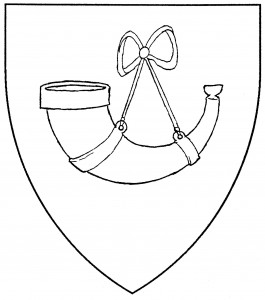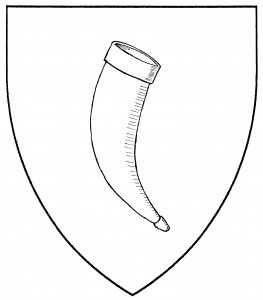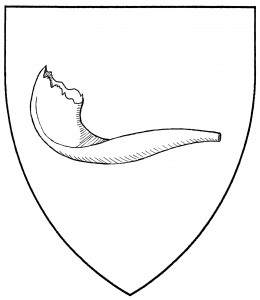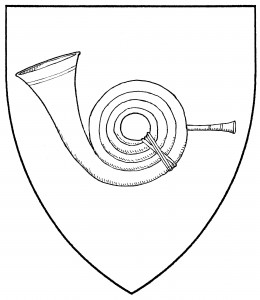A horn is an artifact, made from an animal’s horn, from which it gets its name. The default horn is a musical instrument, more fully blazoned a “hunting horn” or “bugle horn”; it is found in the canting arms of Hornes c.1275 [ANA2 476]. It’s usually shown hung on cords, and may be garnished in bands of another tincture; these are considered artistic details. In mundane armory, the hunting horn’s default orientation has changed over time; the Society default is fesswise, embowed to base, with bell to dexter.
Another use of the horn is as a drinking vessel; this is blazoned a “drinking horn”. Unlike the hunting horn, it has no mouthpiece, and is not corded; it was usually shown unadorned, but in at least one instance was depicted with feet (so it could be set on a table without spilling), in the arms of Müris, c.1340 [Zurich 94]. In medieval heraldry, it seems to have had the same default orientation as the hunting horn; in Society armory, its default orientation is palewise, embowed to dexter, with bell to chief.
Pairs of drinking horns are common in Saracenic heraldry, where they are referred to as “trousers of nobility” [Mayer 19]; but the motif is blazoned in most European contexts as “a pair of drinking horns”. By Society convention, a pair of drinking horns is “addorsed” (i.e., with the convex sides facing each other) by default; a pair of drinking horns “respectant” will have their convex sides outward. A “pair of drinking horns” is thus distinguished from “two drinking horns”, each in its default orientation.
Of the horns with special names, the best known is the “shofar”, the ram’s horn blown on Jewish high holidays. Depictions of the shofar date back at least to the 4th Century, as seen on a Roman bowl now in the Metropolitan Museum of Art. Though not found as a period heraldic charge, as a period artifact, the shofar is registerable in the Society.
There’s also the “spiral horn”, more fully blazoned a “spiral hunting horn”. This isn’t made from animal horn at all, but from metal: essentially a flat spiral trumpet, the ancestor of the modern French horn. The illustration is based on an artifact dated 1570 [Montagu 107]; as a period artifact, the spiral hunting horn is registerable in the Society, though no heraldic examples have been found.
As with the hunting horn, the shofar and the spiral horn have their bells to dexter by Society default. For related charges, see cornetto, sackbut. See also inkbottle, tooth.
The Shire of Darton bears: Sable, a hunting horn within a laurel wreath Or.
Magnus Birchleg bears: Gules, a drinking horn bendwise sinister argent.
Rivka bat Schmuel Alfasi bears: Per fess indented azure and gules, in pale a shofar, bell to sinister, and an estoile of eight rays Or.
Nikolaj Zrogowacialy bears: Barry argent and azure, a spiral horn of three spirals reversed Or.



